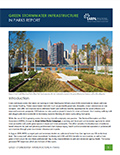 Cities and towns across the nation are turning to Green Stormwater Infrastructure (GSI) investments to reduce and treat stormwater flooding. These nature-based methods, such as permeable pavement, bioswales, stream restorations or tree canopies, also offer communities many additional health and wellness benefits, opportunities for social cohesion and improved economic prosperity. This report highlights green infrastructure projects at park systems, including issues surrounding funding, stakeholder engagement, and how to measure these investments’ long-term benefits.
Cities and towns across the nation are turning to Green Stormwater Infrastructure (GSI) investments to reduce and treat stormwater flooding. These nature-based methods, such as permeable pavement, bioswales, stream restorations or tree canopies, also offer communities many additional health and wellness benefits, opportunities for social cohesion and improved economic prosperity. This report highlights green infrastructure projects at park systems, including issues surrounding funding, stakeholder engagement, and how to measure these investments’ long-term benefits.
 NRPA’s Awareness and the Use of Parks report explores the role awareness plays in driving park and recreation usage and presents a series of steps that park and recreation leaders should consider when executing an awareness strategy. The report also studies the steps taken by two cutting edge park and recreation agencies to promote greater awareness of their offerings.
NRPA’s Awareness and the Use of Parks report explores the role awareness plays in driving park and recreation usage and presents a series of steps that park and recreation leaders should consider when executing an awareness strategy. The report also studies the steps taken by two cutting edge park and recreation agencies to promote greater awareness of their offerings.
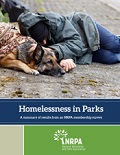 Historically, park and recreation agencies have had a complicated relationship with the homeless community they serve. On one level, public parks are resources for the entire community, providing valuable services to all people. On another level, the prevalence of homeless individuals using park resources can put great pressure on the finite resources of park and recreation agencies. The circumstances of homelessness vary significantly by city, with each park and recreation agency facing a unique set of challenges and holding a unique perspective. As a result, mitigating homelessness cannot be the sole responsibility of one agency or one department within a city. In all, nine out of 10 urban park and recreation agency directors report that their city has tactics and strategies in place to alleviate homelessness in the community.
Historically, park and recreation agencies have had a complicated relationship with the homeless community they serve. On one level, public parks are resources for the entire community, providing valuable services to all people. On another level, the prevalence of homeless individuals using park resources can put great pressure on the finite resources of park and recreation agencies. The circumstances of homelessness vary significantly by city, with each park and recreation agency facing a unique set of challenges and holding a unique perspective. As a result, mitigating homelessness cannot be the sole responsibility of one agency or one department within a city. In all, nine out of 10 urban park and recreation agency directors report that their city has tactics and strategies in place to alleviate homelessness in the community.
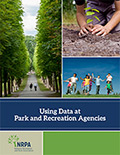 In recent years, park and recreation professionals have increased their use of data analysis to support decision making. The insights gleaned from data analysis help agencies make informed programming decisions for their facilities, help optimize capital expenditure budgets and support master planning. At the same time, many park and recreation agencies face the daunting challenge of identifying how to best take advantage of the great promise data can bring to their agencies. Based on the feedback of 58 directors from urban park and recreation agencies, this study looks at how park and recreation agencies are embracing data today and to identify the barriers that inhibit greater use of analysis.
In recent years, park and recreation professionals have increased their use of data analysis to support decision making. The insights gleaned from data analysis help agencies make informed programming decisions for their facilities, help optimize capital expenditure budgets and support master planning. At the same time, many park and recreation agencies face the daunting challenge of identifying how to best take advantage of the great promise data can bring to their agencies. Based on the feedback of 58 directors from urban park and recreation agencies, this study looks at how park and recreation agencies are embracing data today and to identify the barriers that inhibit greater use of analysis.
 Americans cherish their local public park and recreation services, seeing them as valuable features of their communities, towns and cities. In fact, Americans almost unanimously agree that their communities benefit from their local public parks, even if they are not regular park users. This passion for local public parks has gone unabated during the past 25 years even as our nation and the ways we interact and entertain each other have dramatically evolved. Read the study and dig deeper with interactive graphics.
Americans cherish their local public park and recreation services, seeing them as valuable features of their communities, towns and cities. In fact, Americans almost unanimously agree that their communities benefit from their local public parks, even if they are not regular park users. This passion for local public parks has gone unabated during the past 25 years even as our nation and the ways we interact and entertain each other have dramatically evolved. Read the study and dig deeper with interactive graphics.
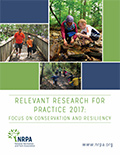 The following reports translate key academic research findings for everyday park and recreation professionals. Included are summaries of more than 70 peer-reviewed research articles published between 2012 and 2017. For each report, you will find a summary of each articles’ key findings, the full reference, contact information of the primary authors and (if available) links to download the full academic articles.
The following reports translate key academic research findings for everyday park and recreation professionals. Included are summaries of more than 70 peer-reviewed research articles published between 2012 and 2017. For each report, you will find a summary of each articles’ key findings, the full reference, contact information of the primary authors and (if available) links to download the full academic articles.
Read more about key academic research findings here.
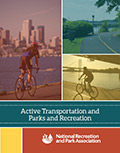 Parks and recreation agencies have historically been closely aligned with the goals of active transportation principles, as well as playing an important role in the development and management of active transportation infrastructure. It is difficult to imagine a truly comprehensive active transportation network that is not touched by a park and recreation agency, and in many cases parks and recreation agencies are the primary providers of active transportation-related services. Through active transportation, parks and recreation agencies provide valuable benefits to communities by providing an engine for economic development, increasing health and wellbeing, supporting conservation and providing benefits to all advocates regardless of socioeconomic status. Download Active Transportation and Parks and Recreation.
Parks and recreation agencies have historically been closely aligned with the goals of active transportation principles, as well as playing an important role in the development and management of active transportation infrastructure. It is difficult to imagine a truly comprehensive active transportation network that is not touched by a park and recreation agency, and in many cases parks and recreation agencies are the primary providers of active transportation-related services. Through active transportation, parks and recreation agencies provide valuable benefits to communities by providing an engine for economic development, increasing health and wellbeing, supporting conservation and providing benefits to all advocates regardless of socioeconomic status. Download Active Transportation and Parks and Recreation.
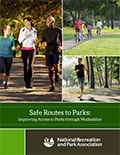 Access to parks increases one's level of physical activity, therefore parks are an important destination that should be easily accessible to all advocates. This report explores the obstacles limiting walkability to parks and identify the essential elements of a safe route to a park. Additionally, this report assesses the barriers to walkability, determines the key stakeholders responsible for creating safe routes to parks, identifies strategies on building awareness on the importance of walkability, and recognizes current initiatives on improving safe routes to parks. Download Safe Routes to Parks: Improving Access to Parks through Walkability.
Access to parks increases one's level of physical activity, therefore parks are an important destination that should be easily accessible to all advocates. This report explores the obstacles limiting walkability to parks and identify the essential elements of a safe route to a park. Additionally, this report assesses the barriers to walkability, determines the key stakeholders responsible for creating safe routes to parks, identifies strategies on building awareness on the importance of walkability, and recognizes current initiatives on improving safe routes to parks. Download Safe Routes to Parks: Improving Access to Parks through Walkability.
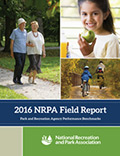 The typical park and recreation agency offers one park for every 2,277 residents served, with 9.5 acres of parkland per 1,000 residents. But park and recreation agencies are as diverse as the communities that they serve, and what works well for one agency may not be best for your agency. Therefore, you need data to best identify the best practices to optimally serve your community.
The typical park and recreation agency offers one park for every 2,277 residents served, with 9.5 acres of parkland per 1,000 residents. But park and recreation agencies are as diverse as the communities that they serve, and what works well for one agency may not be best for your agency. Therefore, you need data to best identify the best practices to optimally serve your community.
That’s where the 2016 NRPA Field Report comes in. This report is the most comprehensive resource of data and insights for park and recreation agencies in the United States, and has 21 figures highlighting critical park and recreation metrics.
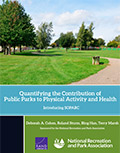 Because public parks contribute to health and well-being, primarily by serving as an important venue for physical activity, it is in the best interests of park administrators to have a method to measure this contribution. While parks offer health benefits beyond physical activity, physical activity can be objectively measured and is an excellent way to demonstrate the value of parks. Learn more in Quantifying the Contribution of Public Parks to Physical Activity and Health. Download Quantifying the Contribution of Public Parks to Physical Activity and Health.
Because public parks contribute to health and well-being, primarily by serving as an important venue for physical activity, it is in the best interests of park administrators to have a method to measure this contribution. While parks offer health benefits beyond physical activity, physical activity can be objectively measured and is an excellent way to demonstrate the value of parks. Learn more in Quantifying the Contribution of Public Parks to Physical Activity and Health. Download Quantifying the Contribution of Public Parks to Physical Activity and Health.
 The Journal Childhood Obesity recently published a Perspective on the role of parks in obesity prevention and improving the public’s health. The article was authored by experts from the CDC, National Park Service and NRPA.
The Journal Childhood Obesity recently published a Perspective on the role of parks in obesity prevention and improving the public’s health. The article was authored by experts from the CDC, National Park Service and NRPA.
The article briefly summarizes some of the obesity related benefits of parks across the local, state, and national park systems and highlights specific initiatives as examples of the commitment by park agencies to benefit the public’s health and play a role in obesity and chronic disease prevention. Download Let’s Go to the Park Today: The Role of Parks in Obesity Prevention and Improving the Public’s Health.
Reprinted with permission from Childhood Obesity, October 2012, Mary Ann Liebert, Inc., publishers.
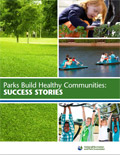 Our country is in a health crisis. Sedentary lifestyles and poor nutrition have contributed to the more than one-third of adults and approximately 17 percent of children in the U.S. being obese. Parks and recreation can help inspire a healthier America.
Our country is in a health crisis. Sedentary lifestyles and poor nutrition have contributed to the more than one-third of adults and approximately 17 percent of children in the U.S. being obese. Parks and recreation can help inspire a healthier America.
This publication collects the best and most successful strategies leveraged since 2009 that have proved effective for building healthy communities through parks and recreation. These case studies offer valuable insights for others seeking to take a stand and become leaders in their community for fighting the battle of obesity. Download Parks Build Healthy Communities: Success Stories.
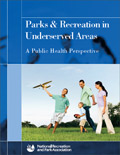 In light of the urgency of the obesity epidemic and available research, it is essential for park and recreation agencies to review and reevaluate the aspects of parks that can potentially have a lasting impact on the future of public health.
In light of the urgency of the obesity epidemic and available research, it is essential for park and recreation agencies to review and reevaluate the aspects of parks that can potentially have a lasting impact on the future of public health.
This paper takes a closer look at how park use and physical activity levels are influenced by the following factors: distribution and access to public parks and recreation, park facilities and park conditions. Download Parks and Recreation in Underserved Areas.
 The situation facing U.S. parks is stark: A societal resource more popular and beneficial than at any time in history is pitted against those who would cut funding to these very resources.
The situation facing U.S. parks is stark: A societal resource more popular and beneficial than at any time in history is pitted against those who would cut funding to these very resources.
The Synopsis of 2010 Research Papers summarizes the key categories in which parks and recreation contribute to building of healthy, vibrant communities. This white paper outlines in six main areas the latest research into the benefits provided by parks: physical health, mental health, social functioning, youth development, environment, and economic impact.
Read all available industry monographs in their entirety.
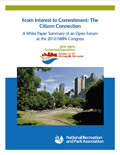 It is generally assumed that citizen participation is a desired and necessary part of any community based initiative. At the same time, the concept is so broad that until this time there has not been a clear-cut and widely agreed upon definition of it. Read about proven successful strategies that have encouraged citizen participation in park and recreation agency events, programs and services, as well as volunteering and advocacy.
It is generally assumed that citizen participation is a desired and necessary part of any community based initiative. At the same time, the concept is so broad that until this time there has not been a clear-cut and widely agreed upon definition of it. Read about proven successful strategies that have encouraged citizen participation in park and recreation agency events, programs and services, as well as volunteering and advocacy.
This white paper report offers park and recreation agencies insights on how to successfully engage park users and the broader public in their organizations. Download From Interest to Commitment: The Citizen Connection.
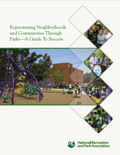 The practice of developing or redeveloping parks, and open spaces, has become a catalyst for revitalizing neighborhoods and communities, throughout the United States. This guide provides inspiration to move park projects forward while giving you strategies and techniques to ensure success.
The practice of developing or redeveloping parks, and open spaces, has become a catalyst for revitalizing neighborhoods and communities, throughout the United States. This guide provides inspiration to move park projects forward while giving you strategies and techniques to ensure success.
Parks are such an essential component of livable, sustainable, communities that it is difficult to imagine a truly livable sustainable community without parks, trails, and other recreational resources and the positive changes such parks create for the entire neighborhood. Download Rejuvenating Neighborhoods and Communities through Parks—A Guide To Success.
Issue Briefs